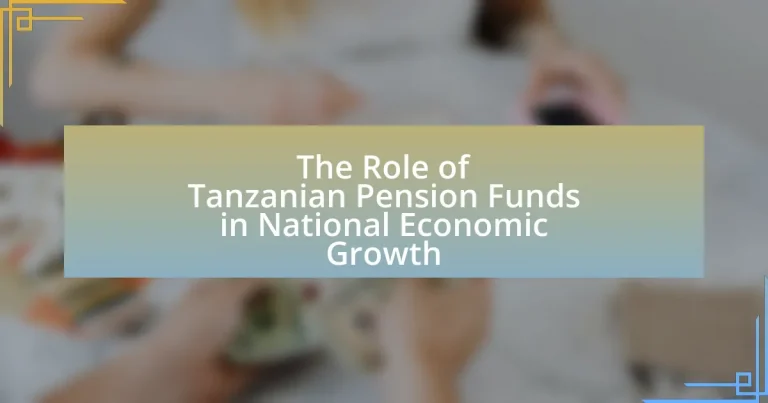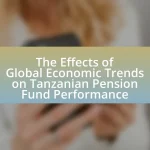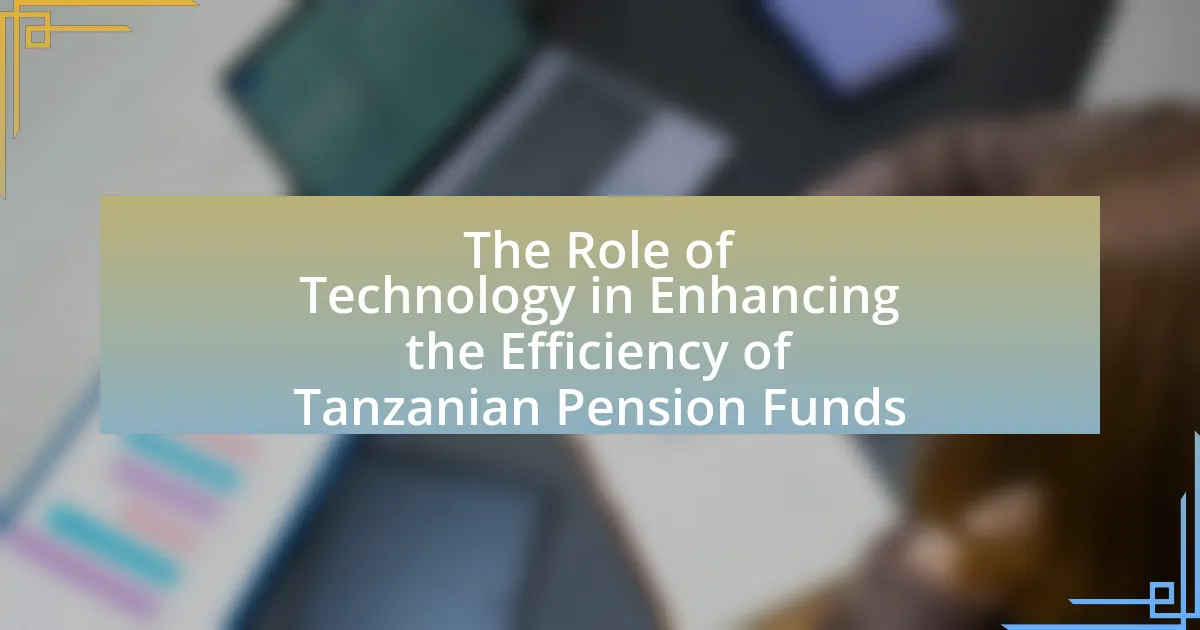Tanzanian pension funds are vital to the country’s economic growth, managing over 5 trillion Tanzanian Shillings and investing in infrastructure, real estate, and energy projects. These funds mobilize domestic savings, provide long-term financing, and contribute to capital market development, thereby enhancing job creation and economic productivity. However, they face challenges such as limited investment opportunities and regulatory constraints that affect their performance. The article explores the functions of pension funds, their impact on financial markets, the risks associated with their investments, and strategies for improving their effectiveness in supporting national economic development.

What is the role of Tanzanian pension funds in national economic growth?
Tanzanian pension funds play a crucial role in national economic growth by mobilizing domestic savings and investing in infrastructure and development projects. These funds, which manage significant assets, contribute to capital market development and provide long-term financing for various sectors, including real estate, energy, and transportation. For instance, as of 2021, Tanzanian pension funds had assets exceeding 5 trillion Tanzanian Shillings, which they allocate to projects that stimulate job creation and enhance economic productivity. By investing in local enterprises and government bonds, these funds not only support economic stability but also foster financial inclusion and promote sustainable development within the country.
How do Tanzanian pension funds contribute to the economy?
Tanzanian pension funds contribute to the economy by mobilizing domestic savings and investing in infrastructure and development projects. These funds, which manage over 5 trillion Tanzanian shillings, play a crucial role in financing long-term projects that stimulate economic growth. For instance, investments in sectors such as real estate, energy, and transportation not only create jobs but also enhance productivity. Additionally, pension funds provide a stable source of capital for businesses, fostering entrepreneurship and innovation. By diversifying their investment portfolios, these funds also help stabilize the financial system, contributing to overall economic resilience.
What are the primary functions of pension funds in Tanzania?
The primary functions of pension funds in Tanzania include providing retirement benefits, managing savings for future payouts, and investing in national development projects. These funds collect contributions from employees and employers, which are then pooled and invested to generate returns. According to the National Social Security Fund (NSSF) of Tanzania, pension funds play a crucial role in enhancing financial security for retirees, thereby contributing to economic stability. Additionally, pension funds invest in infrastructure and real estate, which supports national economic growth by creating jobs and improving public services.
How do pension funds influence investment in infrastructure?
Pension funds influence investment in infrastructure by providing substantial capital for long-term projects, which is essential for infrastructure development. In Tanzania, pension funds have increasingly allocated resources to infrastructure projects, recognizing the potential for stable returns and economic growth. For instance, the National Social Security Fund (NSSF) has invested in various infrastructure initiatives, including roads and energy projects, contributing to national development. This trend is supported by the fact that pension funds globally manage over $40 trillion in assets, making them significant players in financing infrastructure, which often requires large upfront investments and offers long-term cash flows.
Why are pension funds important for economic stability?
Pension funds are important for economic stability because they provide a long-term source of capital that supports investment in various sectors. By pooling savings from individuals, pension funds enable significant investments in infrastructure, real estate, and businesses, which can stimulate economic growth. For instance, in Tanzania, pension funds have been instrumental in financing large-scale projects, contributing to job creation and enhancing productivity. According to the National Social Security Fund of Tanzania, pension funds have invested over 1 trillion Tanzanian Shillings in infrastructure development, demonstrating their critical role in fostering economic resilience and stability.
What role do pension funds play in financial markets?
Pension funds play a crucial role in financial markets by acting as significant institutional investors that provide capital for various financial instruments. They invest in equities, bonds, real estate, and other assets, which helps to enhance market liquidity and stability. For instance, in 2020, global pension funds managed approximately $40 trillion in assets, making them key players in capital allocation and influencing market trends. Their long-term investment horizon allows them to support economic growth by funding infrastructure projects and corporate expansions, thereby contributing to overall national economic development.
How do pension funds affect savings and investment rates?
Pension funds significantly influence savings and investment rates by pooling capital from individual contributions and directing it into various investment vehicles. This aggregation of funds increases the overall capital available for investment in the economy, which can lead to higher investment rates. For instance, in Tanzania, pension funds have been shown to contribute to infrastructure development and other long-term projects, thereby stimulating economic growth. According to the National Bureau of Statistics of Tanzania, pension funds accounted for approximately 10% of total national savings in recent years, demonstrating their critical role in enhancing savings rates. This relationship between pension funds and investment rates is essential for fostering sustainable economic development.

What challenges do Tanzanian pension funds face in promoting economic growth?
Tanzanian pension funds face significant challenges in promoting economic growth, primarily due to limited investment opportunities and regulatory constraints. The pension funds are often restricted in their ability to invest in diverse asset classes, which hampers their potential to generate higher returns that could contribute to economic development. Additionally, the regulatory framework governing these funds can be rigid, limiting their flexibility to adapt to changing market conditions. For instance, a report by the Bank of Tanzania highlights that pension funds have a high concentration in government securities, which yields lower returns compared to other investment avenues. This lack of diversification not only affects the funds’ growth but also their capacity to stimulate broader economic activity through investments in infrastructure and private sector development.
How do regulatory frameworks impact pension fund operations?
Regulatory frameworks significantly impact pension fund operations by establishing the rules and guidelines that govern fund management, investment strategies, and compliance requirements. These frameworks ensure that pension funds operate within legal boundaries, promoting transparency and protecting the interests of beneficiaries. For instance, in Tanzania, the Pension Funds Act mandates specific investment limits and risk management practices, which directly influence how pension funds allocate their assets. This regulatory oversight helps maintain financial stability and encourages prudent investment, ultimately contributing to the national economy by ensuring that pension funds can meet their long-term obligations to retirees.
What are the key regulations affecting Tanzanian pension funds?
The key regulations affecting Tanzanian pension funds include the Pension Act of 2008, which establishes the legal framework for pension schemes, and the Social Security Regulatory Authority (SSRA) guidelines that oversee compliance and governance. The Pension Act mandates minimum funding levels and investment guidelines to ensure the sustainability of pension funds. Additionally, the SSRA enforces regulations on the management of pension assets, requiring transparency and accountability from fund managers. These regulations aim to protect beneficiaries’ interests and promote the stability of the pension system in Tanzania.
How do these regulations influence fund performance?
Regulations significantly influence fund performance by establishing guidelines that govern investment strategies, risk management, and reporting standards. For instance, regulations may limit the types of assets pension funds can invest in, which can affect diversification and potential returns. A study by the World Bank in 2021 indicated that stricter regulatory frameworks in emerging markets, including Tanzania, led to improved transparency and accountability, ultimately enhancing fund performance. Additionally, compliance with regulations can reduce operational risks and increase investor confidence, which can positively impact fund inflows and overall performance metrics.
What are the risks associated with pension fund investments?
Pension fund investments carry several risks, including market risk, interest rate risk, credit risk, and liquidity risk. Market risk arises from fluctuations in asset prices, which can lead to significant losses in the fund’s portfolio. Interest rate risk affects the value of fixed-income securities held by the fund; as interest rates rise, the value of existing bonds typically falls. Credit risk involves the possibility of default by issuers of securities, which can result in losses for the fund. Liquidity risk refers to the difficulty of selling assets without incurring substantial losses, particularly in volatile market conditions. These risks can impact the overall performance and stability of pension funds, affecting their ability to meet future obligations to retirees.
How do market fluctuations affect pension fund returns?
Market fluctuations significantly impact pension fund returns by altering the value of the assets held within the fund. When markets experience volatility, the prices of stocks, bonds, and other investments can rise or fall sharply, directly affecting the overall portfolio value of pension funds. For instance, during the 2008 financial crisis, many pension funds saw their asset values decline by over 20%, leading to reduced returns for beneficiaries. This relationship underscores the sensitivity of pension fund performance to market conditions, as funds must navigate these fluctuations to meet their long-term obligations to retirees.
What measures can be taken to mitigate investment risks?
To mitigate investment risks, diversification is essential, as it spreads investments across various asset classes, reducing exposure to any single investment’s poor performance. For instance, a study by Markowitz (1952) demonstrated that a diversified portfolio can lower volatility and enhance returns over time. Additionally, conducting thorough due diligence on investment opportunities helps identify potential risks and rewards, ensuring informed decision-making. Implementing risk management strategies, such as setting stop-loss orders and regularly reviewing portfolio performance, further protects against significant losses. These measures collectively contribute to a more stable investment environment, particularly for Tanzanian pension funds aiming to support national economic growth.

What strategies can enhance the effectiveness of Tanzanian pension funds?
To enhance the effectiveness of Tanzanian pension funds, implementing diversified investment strategies is crucial. Diversification allows pension funds to spread risk across various asset classes, such as equities, bonds, real estate, and infrastructure projects, which can lead to more stable returns. For instance, the National Social Security Fund (NSSF) in Tanzania has successfully invested in real estate and infrastructure, yielding higher returns compared to traditional investments. Additionally, adopting robust governance frameworks and improving regulatory compliance can further strengthen the management of pension funds, ensuring transparency and accountability. Research indicates that well-governed pension funds tend to perform better, as seen in various global benchmarks.
How can pension funds diversify their investment portfolios?
Pension funds can diversify their investment portfolios by allocating assets across various asset classes, including equities, fixed income, real estate, and alternative investments. This strategy reduces risk and enhances potential returns by spreading investments over different sectors and geographic regions. For instance, according to the World Bank, diversification can lower the volatility of returns, as different asset classes often respond differently to economic changes. Additionally, pension funds may invest in domestic and international markets to further mitigate risks associated with local economic downturns.
What types of assets should pension funds consider for diversification?
Pension funds should consider a mix of equities, fixed income securities, real estate, commodities, and alternative investments for diversification. Equities provide growth potential, while fixed income securities offer stability and income. Real estate can serve as a hedge against inflation, and commodities can protect against market volatility. Alternative investments, such as private equity and hedge funds, can enhance returns and reduce correlation with traditional asset classes. This diversified approach helps mitigate risks and improve overall portfolio performance, aligning with the goal of sustainable economic growth in Tanzania.
How does diversification impact overall fund performance?
Diversification positively impacts overall fund performance by reducing risk and enhancing returns. When a fund diversifies its investments across various asset classes, sectors, or geographic regions, it mitigates the potential negative effects of poor performance in any single investment. For instance, a study by Markowitz in 1952 established the foundation of modern portfolio theory, demonstrating that a diversified portfolio can achieve a higher return for a given level of risk compared to a non-diversified portfolio. This principle is particularly relevant for Tanzanian pension funds, as they can stabilize their returns and contribute to national economic growth by investing in a mix of local and international assets.
What best practices can improve pension fund management?
Best practices that can improve pension fund management include implementing robust governance structures, enhancing risk management frameworks, and adopting transparent investment strategies. Effective governance ensures accountability and aligns the interests of stakeholders, which is crucial for long-term sustainability. For instance, the International Organization of Pension Supervisors emphasizes that strong governance can lead to better decision-making and performance outcomes. Additionally, a comprehensive risk management framework allows pension funds to identify, assess, and mitigate potential risks, thereby safeguarding assets. Research from the World Bank indicates that pension funds with advanced risk management practices tend to achieve higher returns. Lastly, transparent investment strategies foster trust among beneficiaries and can lead to increased contributions, as evidenced by studies showing that transparency correlates with higher member satisfaction and engagement.
How can transparency and accountability be increased in pension fund operations?
Transparency and accountability in pension fund operations can be increased through the implementation of robust regulatory frameworks and regular audits. Regulatory bodies, such as the Pension Fund Regulatory Authority in Tanzania, can enforce strict compliance standards that require pension funds to disclose financial statements, investment strategies, and performance metrics. Regular independent audits can ensure that funds are managed according to established guidelines, thereby enhancing trust among stakeholders. For instance, the International Organization of Pension Supervisors emphasizes that transparency in reporting and governance structures leads to improved accountability and better management of pension assets.
What role does technology play in enhancing pension fund management?
Technology plays a crucial role in enhancing pension fund management by improving efficiency, accuracy, and decision-making processes. Advanced data analytics tools enable pension fund managers to analyze vast amounts of financial data, leading to better investment strategies and risk management. For instance, the use of artificial intelligence and machine learning algorithms allows for predictive modeling, which can forecast market trends and optimize asset allocation. Additionally, technology facilitates real-time monitoring of fund performance, ensuring that managers can make informed decisions quickly. According to a report by Deloitte, 70% of pension funds that adopted technology-driven solutions reported improved operational efficiency and enhanced investment outcomes. This demonstrates that technology not only streamlines processes but also contributes to the overall effectiveness of pension fund management.
What practical steps can stakeholders take to support pension funds in economic growth?
Stakeholders can support pension funds in economic growth by enhancing regulatory frameworks that promote investment in local infrastructure projects. By creating policies that incentivize pension funds to allocate a portion of their assets to domestic development initiatives, stakeholders can stimulate job creation and economic activity. For instance, the Tanzanian government has the potential to implement tax breaks for pension funds investing in sectors like renewable energy or transportation, which can lead to sustainable economic growth. Additionally, fostering partnerships between pension funds and local businesses can ensure that investments are aligned with national development goals, thereby maximizing the impact on the economy.





